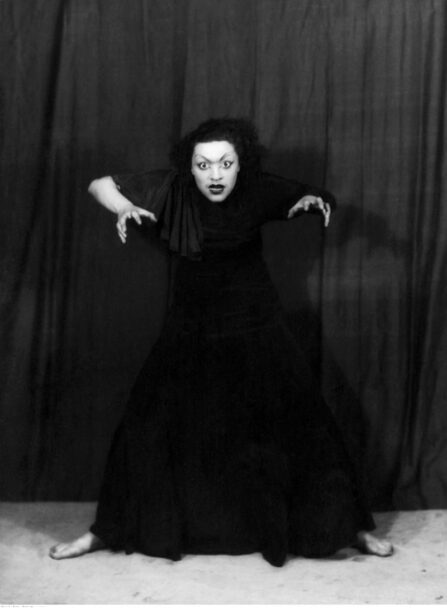
Pola Nireńska w „Krzyku”, 1933, źródło Narodowe Archiwum Cyfrowe
To celebrate the 100th anniversary of Poland?s regained independence, in 2018 the Adam Mickiewicz Institute launched the Choreographic Territories ? New Paths of the Avant Garde project. It revolves around Polish female dance icons and their exceptional life stories. The Institute has invited to the project dancers and choreographers of the young generation, who take a close look at the Polish icons of choreography around the world.
On the 26th of April, Second Nature by Agata Siniarska and Karolian Grzywnowicz with a performance of Katarzyna Wolińska premieres at the Erbstücke festival opening in Dresden. The performance is based on the only preserved recordings Pola Nireńska?s Holocaust Tetralogy, the last work of this outstanding artist, a charismatic personality, and Jan Karski?s wife. After Dresden, where young Nireńska honed her skills in the legendary Mary Wigman?s school, Second Nature will travel to Warsaw, Prague and Bucharest and other European cities.
The inspiration for the Choreographic Territories ? New Paths of the Avant Garde are female choreographers and dancers such as Yanka Rudzka, Marie Rambert, Pola Nireńska, and Bronisława Niżyńska. These women made the history of dance. The Adam Mickiewicz Institute honours their legacy by bringing back the intercultural exchange model known from the beginnings of the 20th century – working with the local dancers and choreographers, while emphasising the omnipresent spirit of the artists with Polish roots.
Just like in the 20s and 30s, Polish artists can still be a source of inspiration and present the modern approach to choreography in other countries. Hence, apart from showcasing the new choreographic works, the Institute presents the modern dance scene, while the audience and the local artistic circles gain the chance to participate in master classes conducted by Polish dancers and choreographers. As the project aims at strengthening the position of modern dance in Central and Eastern Europe, the events take place in a selection of countries in the region.
The series started in 2018 with The Yanka Rudzka Project: Polyphonies by Joanna Leśnierowska, starring artists from Poland, Georgia, Armenia and Brazil. The show, merging the four cultures, was presented during the first tour of the Choreographic Territories project: in Grodno, Minsk, Dnipro, Tbilisi, Yerevan and Kiev.
This time, the project focuses exclusively on Pola Nireńska, who, as a Polish Jew, lost her family in the Holocaust. Agata Siniarska and Karolina Grzywnowicz based Second Nature on her life and legacy.
Siniarska says that their ?choreography protects the memory, becoming bodily and physical historiography, a living archive existing in between change and regression, preservation and loss.
Second Nature is set in the context of Karolina Grzywnowicz?s installation in the form of a garden, whose design allows it to be a separate and independent space. The installation, as explained by the designer, ?draws from the concept of a garden as taming nature as well as from the Naturgarten idea. It was a notion adopted by the Nazis, according to which any non-native plant species should be rooted out. This way of thinking is a link to Nireńska, who was harassed for her origin?.
The installation has been supported by the Pilecki Institute, a new research and cultural institution, whose objective is to create an international digital archive about Poland during the World War II. Siniarska?s and Grzywnowicz?s piece presents the surrounding landscape as an eco-witness of past violence, as well as points out the abuse of nature and the current environment exploitation.
The Second Nature premiere will open another series of the Choreographic Territories dance performances, happening in Prague, Žilina, Bucharest and Plovdiv. The international audience will also see a selection of the Polish Dance Platform performances such as Zrób siebie by Marta Ziółek (Komuna//Warszawa), Jumpcore by Pawła Sakowicza, Łuczniczki by Agnieszka Kryst, Welcome/Witajcie by Aurora Lubos and spectral layers of movement by Grupa Wokół Centrum.
Second Nature
Concept: Agata Siniarska, Karolina Grzywnowicz / Installation: Karolina Grzywnowicz / Choreography: Agata Siniarska, Katarzyna Wolińska inspired by Tetralogy of Holocaust by Pola Nirenska, Bacchanal by Isadora Duncan, Extinct Animals by Marcus Coates / Performance: Katarzyna Wolińska / Dramatic consulting: Mateusz Szymanówka / Consulting: Aleksandra Jach, Aleksandra Janus, Franziska Dieterich, Jacek Małczyński, Magdalena Zamorska, Michal Guzik, Weronika Kostyrko / Production: Artists Association Four Dimensions Are Not Enough for Us, Agata Siniarska, Karolina Grzywnowicz / Co-production: Hellerau European Centre for the Arts
The production has been carried out as a part of the Choreographic Territories ? new paths of the avant-garde project, held by the Adam Mickiewicz Institute in collaboration between the Institute of Music and Dance, Hellerau European Centre for the Arts, East European Performing Arts Platform, Art Stations Foundation by Grażyna Kulczyk and Lublin Dance Theatre. The installation was produced in co-operation with Pilecki Institute.
The project is held by the Adam Mickiewicz Institute as part of POLSKA 100, the international cultural programme accompanying the centenary of Poland regaining independence. Co-financed by the Ministry of Culture and National Heritage of the Republic of Poland as part of the multi-annual programme NIEPODLEGŁA 2017?2022.
For more information please visit: culture.pl